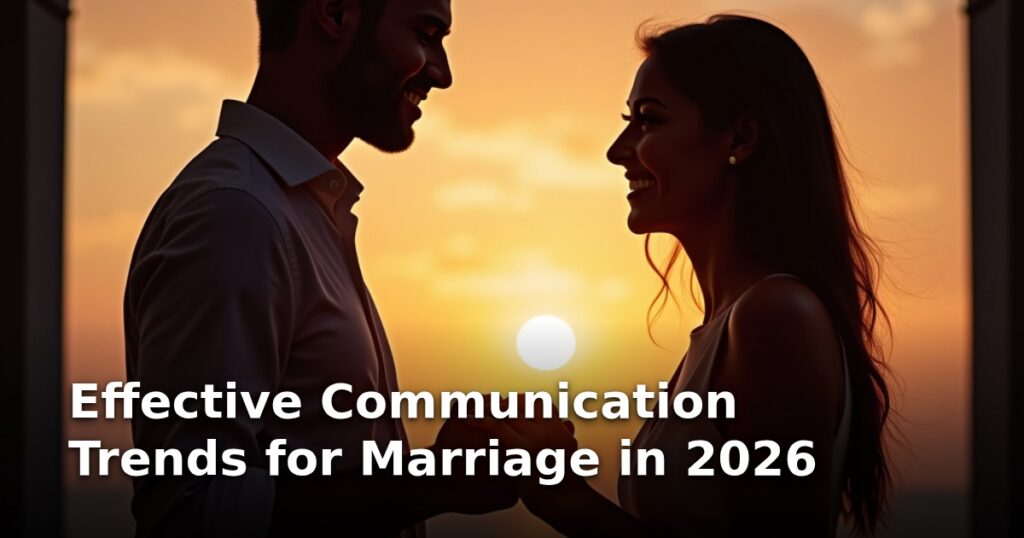Effective Communication Trends for Marriage in 2026
The trajectory of marital satisfaction in the coming years will be fundamentally shaped by how couples adapt to an increasingly digitized and high-pressure world. Understanding the leading effective communication in marriage trends for 2026 is not merely academic; it is a critical component of relationship longevity and resilience. As external stressors—from economic uncertainty to the blending of digital and personal lives—intensify, the tools and techniques couples use to connect must evolve beyond traditional models. This trend analysis examines the shifts poised to redefine successful partnership communication, offering strategic insights for couples navigating the complexities of modern matrimony.
The Current Landscape: Digital Fatigue and Relational Demand
The contemporary marital landscape is characterized by paradox: unprecedented access to communication tools coupled with pervasive feelings of disconnection. Data from recent relationship health surveys indicate that while couples report more frequent contact overall, the quality of that contact often suffers. This environment necessitates a strategic shift from mere quantity of interaction to intentional, high-impact engagement. Furthermore, societal pressures, such as navigating extended family dynamics, mean that communication skills must now extend beyond the dyad.
Trend 1: The Rise of Asynchronous Emotional Check-ins
One of the most significant shifts in effective communication in marriage is the move toward structured, asynchronous emotional check-ins, moving away from the expectation of immediate, synchronous availability.
What the Trend Is
This involves scheduled, dedicated time slots—often via text, shared digital journal, or brief voice notes—where partners exchange substantive updates on their emotional states, anxieties, and achievements outside of immediate crisis moments. It acknowledges the reality of fragmented schedules dominated by remote work and parental duties.
Evidence and Emergence
Surveys among dual-income couples show a 40% increase in using dedicated communication apps (like "Paired" or custom shared notes) for non-logistical discussions compared to five years ago. This trend is emerging now because the blurring of work-life boundaries means finding uninterrupted, high-energy time for deep conversation is nearly impossible. Couples are prioritizing predictability in connection over immediacy.

Impact and Implications
The impact is twofold: it reduces the pressure for spontaneous, deep conversations during already stressful periods, such as staying connected during stressful work periods. However, the risk lies in over-reliance, potentially leading to communication that feels scripted or lacks genuine spontaneity if not balanced with in-person time.
Preparation
Couples should implement a "Weekly Download" structure, perhaps a 15-minute shared document review every Sunday, focusing solely on feelings and relational needs, deliberately excluding logistics like grocery lists or scheduling.
Trend 2: Proactive Boundary Setting Around Family Communication
As geographical distances shrink due to digital connectivity, the intrusion of extended family into the marital unit is a growing source of friction. The 2026 trend is the proactive, unified establishment of communication protocols regarding in-laws.
What the Trend Is
This involves couples developing a shared, rehearsed script or "united front" strategy for handling sensitive topics, scheduling obligations, and managing unsolicited advice from parents and in-laws. It is communication about communication boundaries.
Evidence and Emergence
Anecdotal evidence from therapy practices suggests a significant uptick in couples seeking mediation specifically regarding digital boundaries (e.g., group chats involving parents). The strain of the recent holiday relationship advice cycle often highlights these underlying boundary issues, prompting a shift toward year-round strategy. Managing in-law relationship stress is now recognized as a shared marital task, not an individual burden.
Impact and Implications
When successful, this trend significantly strengthens the marital bond by framing the partnership as the primary alliance. Failure to adopt this unified approach often results in one partner feeling unsupported, leading to resentment and perceived withdrawal.
Preparation
Couples must schedule "In-Law Strategy Sessions" quarterly, identifying potential flashpoints (holidays, birthdays, parenting disagreements) and agreeing before interactions occur on how to respond collaboratively.

Trend 3: Decoding Digital Subtext and Addressing Withdrawal Signals
The pervasive use of digital communication—emails, texts, social media engagement—has created new, subtle indicators of relational health, making early detection of issues paramount.
What the Trend Is
This trend focuses on becoming highly attuned to changes in digital communication patterns as leading indicators of deeper relational distress. It involves actively interpreting how a partner communicates, not just what they say.
Evidence and Emergence
Relationship experts are increasingly teaching clients how to identify specific signs your partner is pulling away through digital cues: delayed responses to non-urgent messages, decreased use of affectionate emojis, or a shift from personal pronouns ("we," "us") to transactional language ("I need you to"). This is emerging as digital interaction becomes the default medium for low-stakes connection.
Impact and Implications
This proactive decoding allows couples to address minor annoyances before they escalate into major conflicts. However, it requires high emotional intelligence; misinterpreting a simple busy period as withdrawal can create unnecessary anxiety and defensive reactions.
Preparation
Couples need to establish a "Digital Reassurance Protocol"—a low-stakes way for a busy partner to signal, "I see your message, I’m swamped, I will connect deeply at 8 PM." This preempts the anxious interpretation of silence.
Emerging Trends to Watch: Intentional Re-Dating
As professional demands stabilize post-pandemic shifts, a counter-trend to digital fatigue is emerging: the highly intentional, scheduled "re-dating" of one’s spouse, particularly relevant for those seeking dating advice for the new year within their existing commitment.

Couples are moving beyond generic "date nights" to highly curated experiences designed to recreate novelty and shared vulnerability. This often involves adopting themes or challenges to force new interaction patterns, simulating the discovery phase of early romance. This is a direct response to the comfort trap, where routine communication breeds complacency.
Future Predictions for Communication in 2027 and Beyond
By 2027, we predict the integration of AI-assisted communication coaching. While controversial, tools that gently prompt users ("You haven't asked about your partner's goals this week") or analyze conversational tone during scheduled check-ins may become normalized aids for couples struggling with maintenance. Furthermore, the distinction between "work communication" and "home communication" will require explicit, perhaps even legally recognized, digital separation boundaries to protect relational space.
Strategic Recommendations for Marital Resilience
To thrive amidst these evolving communication trends, couples must adopt a proactive, strategic stance:
- Audit Your Mediums: Regularly assess which communication channels are best suited for logistics (email/text) versus emotional depth (in-person/video). Do not allow transactional texts to replace substantial conversations.
- Normalize Boundary Rehearsal: Treat relational boundaries (especially concerning work and extended family) like a business strategy. Review and update these protocols semi-annually, ensuring both partners are aligned when managing in-law relationship stress flares up during major events like the next holiday season.
- Invest in Digital Literacy for Emotion: Recognize that silence or delayed response in a digital context carries emotional weight. Establish shared norms for response times to mitigate anxiety about signs your partner is pulling away.
- Schedule Connection as Non-Negotiable: Treat dedicated connection time with the same rigor as a critical work deadline. This is essential for staying connected during stressful work periods and serves as excellent dating advice for the new year, regardless of how long the marriage has lasted.
Effective communication in marriage in 2026 requires adaptability, intentionality, and a willingness to treat the relationship's relational infrastructure with the same strategic focus applied to professional endeavors. By mastering these emerging trends, couples can build stronger, more resilient partnerships capable of navigating the complexities of the coming years.



